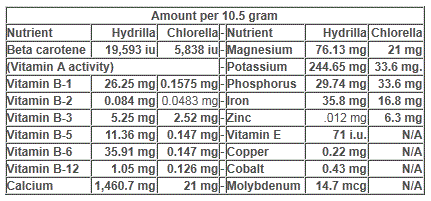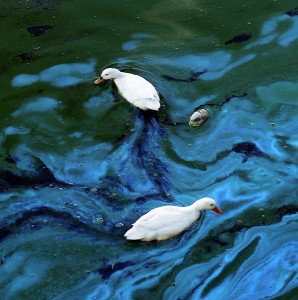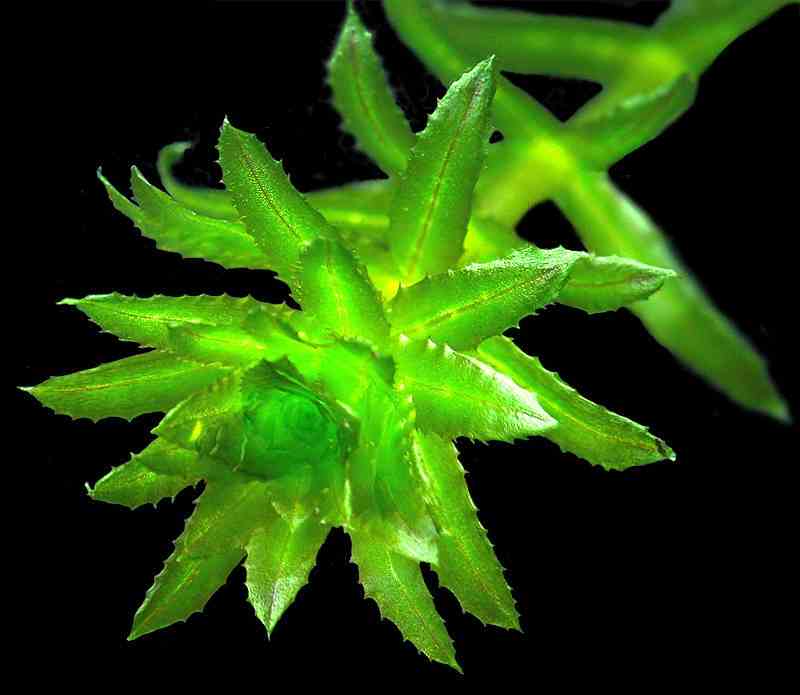
Hydrilla verticillata, photo by Indoaquascape
I am often asked can we eat Hydrilla? The answer is no, and yes.
There is only one species of Hydrilla, verticillata. The Hydrilla you buy in the health food store is the same that clogs lakes around the world. Can you take it out of a lake, cook it up, and chomp it down? No… Well, I don’t know of anyone doing that. But you can buy it as a dried powder to add to soups and stews and smoothies. So what’s the difference?
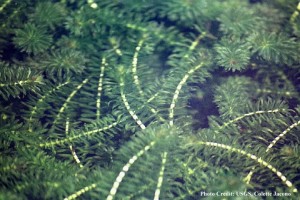
Hydrilla floating on the surface, photo by Colette Jacono
Hydrilla is an Eurasian weed that entered the western hemisphere via Florida sometime in the 1950’s probably through one aquarium dealer who imported live Hydrilla from Sri Lanka. It was subsequently found in a Miami canal, and from there it spread. In fact, for more than a decade no one knew it was Hydrilla. It was mistakenly called Elodea canadensis. However, within 10 years of its discovery Hydrilla became the most troublesome aquatic weed in the state. (It can expand 1,000 percent a year grow an inch a day.) Florida currently spends about $30 million annually trying to control it. The strain that was found in Florida was female. Twenty years later male Hydrilla was first reported in Delaware in 1976.
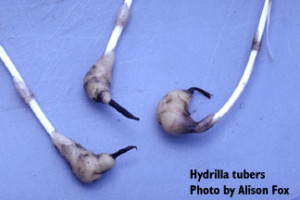
Hydrillas roots, photo by Alison Fox
Since that introduction some 60 years ago Hydrilla is now found in 19 states and Washington DC, from the endotrophic waters of Maine, west to wet Washington state. Called the perfect aquatic plant it adapts to a wide variety of climates and water conditions. Hydrilla can also reproduce four ways: rhizomes, tubers, turions (buds) and fragmentation. It, and Water Hyacinths, are the two most expensive weeds in the world. Because of the economic impact of the species there is a huge amount of information written about Hydrilla as a problem. Historical use of Hydrilla prior to it becoming a “noxious” weed is scant limited to a few references to how it was named and its use in making white sugar (more on that in a moment.)
A search of Chinese literature, for example, shows Hydrilla being cultivated for crab farming, and certain fish farming as well. They eat it. Duck like it, too, and snails. These are all foods the Chinese eat but no mentioning of eating Hydrilla directly. In the Philippines much is made of its nutritional qualities, but again no references found about eating it directly.
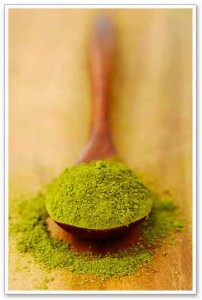
Hydrilla powder, photo by The Healers Store
As for powdered hydrilla… in north Florida they raise Hydrilla in an isolated lake, sterilize it with pure water and ozone treatment, low-temperature dry it, powder it and sell it to you. The mild earthy-flavored powder is 13% calcium which some writers call the richest plant source of calcium on the planet. It’s also high in B-12 and iron. Further, Hydrilla has been investigated as possible animal fodder. It has 16 percent more available dry matter for fodder than cattails and no bad chemicals were found in it during the examination for cattle food. In fact in one study when fed Hydrilla cows gave 20% more milk and chickens 14% more eggs, probably related to the calcium content. But what about Hydrilla as food for people?
As you know I developed and use the I.T.E.M approach to wild foods. Identification, Time of Year, Environment. M is for Method of Preparation. Here’s where the Hydrilla information trail breaks down. I’ve never found any reference in English about consumption of Hydrilla prior to the powdered form. In theory there should be no problem with eating Hydrilla (beyond the possible problems associated with any aquatic plant such as environmental pollution and some algae.) No special processing is done to make it an edible powder. The entire plant is dried and only water removed. So why isn’t Hydrilla used as human food like a cooked green? Well… edible does not mean palatable. As Dick Deuerling used to say about wild food: “I only eat the good stuff.”
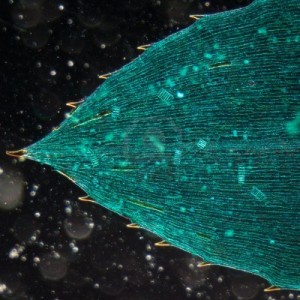
Hydrilla leaf, photo by 123rf
Here’s one possible reason: The plant is tough and prickly, not as bad as many land plants but noticeably so. In fact one quick and easy way to separate it from two similar looking plants (Elodea and Egeria) is to pull Hydrilla through your hand. Edodea and Egeria will feel smooth. Hydrilla will feel harsh and scratchy. It may simply be that texture kept the plant off the dinner table, that and the fact it can grow with just 1% of sunlight. That allows Hydrilla to inhabit cold dark deep areas of lakes one might not want to bother with if there are other edible plants around.
One tentative down side is when water condition are just right (or wrong depending on perspective) there can be a blue-green algae bloom which can grow on the top leaves of Hydrilla. That cyanobacteria can produce toxic chemicals. And while that is a warning about Hydrilla is should be looked out for on every aquatic plant that one might eat (and that includes seaweed as well.) Always avoid blue-green algae.
In English most pre-1960 references to Hydrilla refer to making sugar or naming it. In sugar making a mat of Hydrilla was placed over crystallized brown sugar. Over the next few days moisture from the Hydrilla would percolate through the sugar lightening its color towards white from brown. The whitened sugar would be scraped off and a new layer of Hydrilla added. As for naming the plant…
Hydrilla is fairly easy. It’s from the Greek ύδωρ (EE-dor) or “hydro” in English meaning water thus referring to its water habitat. Verticillata means whorls, as in the leaves. Linnaeus himself named it Serpicula verticillata. Over the centuries it has had many different names. Hottonia serrata, Hydrilla angustifolia, Hydrilla dentata, Hydrilla ovalifolia, Hydrilla wightii, Leptanthes verticillatus, Vallisneria verticillata, and Udora verticillata. One Claude Richard (probably Louis claude Marie Richard, 1754 – 1821) came up with the genus name Hydrilla. As it was a monotypic genus — only one species in it — Linnaeus’ species name verticillata stayed. Thus in time Hydrilla verticillata was dubbed. And while in English we say high-DRILL-ah its botanical pronunciation is: HID-ril-lah ver-ti-ki-LAH-tah.
No, I have not personally tried some. When I find some clean water I will. And special thanks to “Josey” for providing some historical data. To seen an older but good video by the state of Florida on Hydrilla click here.
Green Deane’s Itemized Plant Profile: Hydrilla
IDENTIFICATION: Hydrilla is a submersed plant that can form dense mats. Its stems stems are slender, branched and up to 25 feet long. The small leaves are strap-like and pointed. They grow in whorls of four to eight around the stem. The leaf margins are distinctly saw-toothed. Hydrilla often has one or more sharp teeth along the length of the leaf mid-rib. The midribs of the leaves are reddish in color. Hydrilla produces tiny white flowers on long stalks. It also produces 1/4 inch turions at the leaf axils and tubers attached to the roots in the mud. Tubers are yellowish, potato-like, 1/2 in. long, 1/2 inch broad. They can remain viable for four years. One tuber can produce more than 6,000 new tubers. There are two kinds of Hydrilla in North America, plants with just female blossom and those with male and female blossoms. The easiest way to tell them apart is female flowers consist of three whitish sepals and three translucent petals. Male flowers have three whitish to red petals and three red or brown sepals.
TIME OF YEAR: In North America southern populations overwinter as perennials; northern populations overwinter and regrow from tubers.
ENVIROMENT: Hydrilla can grow in almost any freshwater: springs, lakes, marshes, ditches, rivers, tidal zones with 7% salinity or less. It can grow in a few inches of water, or in water more than 20 feet deep. Hydrilla can grow in low nutrient to high nutrient conditions. It is somewhat winter-hardy though its optimum growth temperature is above 68 F. As mentioned it can grow in only 1% of full sunlight.
METHOD OF PREPARATION: Dried and powdered. Edibility of the tubers, if any, is totally unknown to me.

